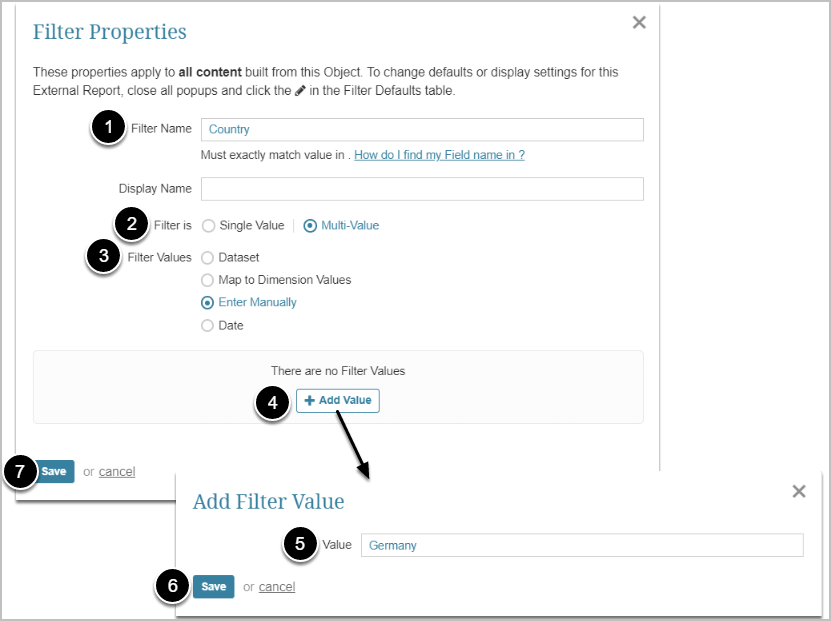This article details how to configure filtering in Domo External Reports.
PREREQUISITES:
2. Define a Source Object for Data Collection
Start by creating an element. Once you get to the process of Data Collection, define the following:
- Choose Data Source that connects Domo and Metric Insights.
- For more information, see Establish Connectivity to Domo
- Choose Card/Dataset from the pop-up list of available Domo objects that can be a source of data
- Each item in the list is represented as the path (hierarchy) to the respective object in Domo.
- If the required item is not displayed, click the Refresh icon at the upper right corner of the pop-up
3. Adding Domo Filters to Metric Insights
Once filters are added for the first time, they are going to be automatically added to all new respective elements with the same Data Source/Report.
NOTE:
- External filters are tied to Domo objects, not Metric Insights' Elements. This allows Filters to be reused for multiple Elements (without creating new Filters every time an Element is created in Metric Insights).
- If there are more External Filters or Filter Values that you would like to use for the current Element, you can always set the redundant ones to "ignore".
When creating an Element from Domo, after you define the Card/Dashboard that should serve as a Data Source, you may pre-filter information that is going to be fetched.
Under Manage Filters > [+Filter], you can choose one of the four options for adding filters. Sections below provide information on how to do this.
NOTE:
- Examples given below are taken from the Domo Dashboard shown at the top of the page.
- Domo Filter Name must exactly match filter names from a Domo Card/Dashboard. Filter names are case sensitive. Unless the match is exact, the Filter will not work.

If you have already created Datasets from Domo in Metric Insights, you can choose one for pre-filtering:
- Enter Domo Filter Name
- Specify if Filter is "Single Value" or "Multiple Value"
- Choose the corresponding option for Filter creation
- Select Dataset & View
- Specify Value Column
- [Save]
NOTE: Datasets used here must have Values that exactly match the Filter Values in Domo (if the Values do not match, the Filter will not work).
4. Map to Dimension Values

If you have already used Domo Filters to create Dimensions in Metric Insights, you can quickly choose which Dimension Values you want to use for pre-filtering:
- Enter Domo Filter Name
- Specify if Filter is "Single Value" or "Multiple Value"
- Choose the corresponding option for filter creation
- Select Dimension
- All Dimension Values are going to be loaded to the Values list automatically
- [Save]
NOTE: Dimensions used here must have Values that exactly match the Filter Values in Domo (if the Values do not match, the Filter will not work).
5. Enter Manually

- Enter Domo Filter Name
- Specify if Filter is "Single Value" or "Multiple Value"
- Choose the corresponding option for Filter creation and [Save] to display the [+Add Value] button
- [+ Add Value]
- Enter the name of the Filter Value
- [Save]
- [Save]
6. Date

- Enter Domo Filter Name
- Specify if Filter is "Single Value" or "Multiple Value"
- Choose the corresponding option for filter creation
- Select Date Format used in Domo
- [Save]
7. Setting Defaults for Filters
Configuring defaults allows for defining Filter defaults for Users viewing this External Report. Defaults may be set the same for everyone or applied based on a User Map. Consequently, any number of Users will have the correct Filter Values when they open their External Report.
Setting the Defaults via a User Map does not restrict Users from viewing non-default Values. It simply sets the Values displayed upon initial viewing. If a User is not in the User Map, the system will initially display the View with no default Values.

- Choose a User Map from the drop-down
- Match the Filters to this User Map
- Proceed with [+Add Mapping] for additional Filters, if needed





